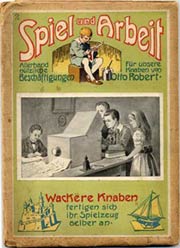
|
| Cardboard Camera Obscuras |
| Most of our camera obscuras are made of wood and a few of metal. The two on this page are unusual because they are both made of cardboard. The first is from the early 19th century and the second from the late in the 20th century. | ||||
| The MIRAGIOSCOPE French Folding Cardboard Camera | ||||
| Direct from a collector in France we have this marvel. As soon as we saw the pictures of it we knew we had to have it but when it arrived we found that it was even better than we expected! | ||||
 |
This camera obscura is made of cardboard and covered with a glossy green and cream geometric pattered paper. It dates from the early 1800s and the condition seems to defy the laws of possibility. When set up the camera is about 10 3/4 inches long, 7 1/4 inches wide, and 5 3/4 inches high. The camera body collapses into a flat rectangle less than 1 1/2 inches high! Along with its lens in a cardboard tube about 2 inches in diameter it then fits into a rather rough wooden box with a paper label inside the lid. The box is not a beautiful object but it must be responsible for keeping the camera in such beautiful condition. It is a marvel of design. When the sides are lifted the mirror raises into position and the front and back can be slipped into place. The hood swings up and two black baffles rest in copper clips. The lens tube slides into a round hole in the front and focuses by moving in and out. Jack discovered for himself that the lens could be reversed for long and close focus before we translated the instructions. A camera of identical construction but with a different patterned paper was offered by Christie's in 2000. It carries a notation "Charles Chevalier, Paris" in the catalog. It is exciting to speculate that it might have been either manufactured or sold by the man who introduced Daguerre and Niepce and corresponded with Talbot! |
|||
|
||||
 |
MIRAGIOSCOPE Set up the device and raise the 2 ends which are folded into the interior.* Place the tube with the lens in the round opening. Fix, using gum adhesive or sealing wax, a square of transfer or transparent paper on the clear glass. Fold back the baffles into the two copper clips, and point the apparatus at the object you want to draw. If the object you are drawing is distant (such as a landscape), place the lens end of the tube into the opening. If, on the other hand, the object is close (like a portrait or an engraving), put the tube into the opening with the lens end facing outwards, and push the tube in or out until the image appears clear on the paper. Foot-note. - Place the subject to be drawn in bright light, and place the Miragioscope in the shade. Paris. - Typ. A. Augros, pass. from Cairo, 87 89. *Hand written note |
|||
| Jumbo Dutch Cardboard Camera Obscura | ||||
The camera obscura below is unusual in several ways. It was made more than a hundred years after the camera above but the body is also made from cardboard. When assembled the center box is about 9" X 7 1/2" X 7". It is a Dutch-made educational kit by Jumbo dated 1978. We bought the assembled camera from a Dutch photographic dealer and later were offered a second complete boxed kit by the same dealer. It is fun to have all the instructions and packing along with an unassembled camera.
|
 |
|||
| Plans for a Cardboard Camera Obscura | ||||
Our collection includes a set of plans and a booklet from a series of projects for boys published c. 1910 in Germany. It is featured on our page of plans for building camera obscuras. Translations of the booklet are ongoing but confirm that the material from which it is made is cardboard. The instructions suggest that the finished camera be covered with wallpaper. This suggests it would look much like the French camera at the top of this page. When the translation if complete we will post a PDF here. |
 |
|||